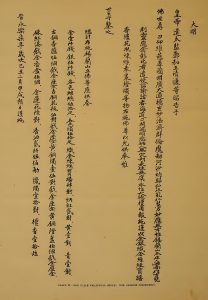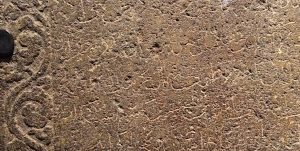OB03129 Kandy Nātha Dēvālē Inscribed Stone Wall
IN03156 Kandy Nātha Dēvālē Stone Inscription 1
This inscription is engraved on four stones built into the western wall of the Nātha Dēvālē in Kandy. The wall includes eight inscribed stones in all, referred to here as A, B, C, D, E, F, G and H. Stones A–E are arranged in one row, while stones F–H form part of the row below. One inscription reads straight across stones A and B, is continued on stone C and concludes on stone D. A separate, fragmentary record begins on stone E and continues on stones F–H. The first of these two inscriptions is dealt with here (see IN03157 for the other). The text is dated on the tenth of the dark half of Bak in the Buddhist year 2085 (30 March, 1543) and records the grant of various concessions by the king Śrī Jayavīra Mahā Väḍa-vun-täna to the people of Dumbara, Pansiyapattuva, Mātalē, and Ūva Tunkin̆da, and of the village Alutgama for their services in an attack by the Portuguese on the Hill Country. The king mentioned here can probably be identified with Jayavīra Baṇḍāra, who is thought to have succeeded to the throne of Kandy in 1511 and reigned until 1552. He was the successor of Sēnāsammata Vikrama Bāhu, who is credited with having founded Kandy as a capital and also with having established (or at least rebuilt) the Nātha Dēvālē, although the current building on the site dates from a later period.
OB03128 Gaḍalādeṇiya Slab-Pillar
Gadaladeniya Vihara, Kandy, Sri Lanka
IN03155 Gaḍalādeṇiya Slab-Pillar Inscription
This inscription is engraved on a slab pillar, which now stands outside the main entrance of the Gaḍalādeṇiya Vihārē, a foundation of the fourteenth century situated in Uḍunuvara of Kandy District. The pillar was set up in its present position by H. C. P. Bell, Archaeological Commissioner, who found it inside the temple. All four faces of the pillar are inscribed. On the front of the slab is a record dated in the fifth year of king Siri San̆gbō Śrī Jayavīra Parākrama Bāhu, which grants an amnesty to Mēṇavara Tuṇayan, nephew of the ǟpā Parākrama Bāhu of Doḍamvela, and the people of the Five Countries, on the reduction of the Hill Country then recently effected before the Coronation Festival held on the twelfth of the bright half of Vesak. This text is preceded on one of the narrow sides of the slab by the word Siddhi engraved beneath the sun and moon, a cakra and conch shell. On the reverse of the slab, continued on the other narrow side, is the undertaking of the rebels to be faithful to His Majesty; their leader is here called Mēṇavara Tuṇayārun. Codrington tentatively suggests that the king Siri San̆gbō Śrī Jayavīra Parākrama Bāhu of this inscription may have been Parākrama Bāhu IX, whose coronation took place in 1509 and whose reduction of the Hill Country is recorded in the Rājāvaliya. This would make the date of the inscription 30 September 1513.
OB03127 Gaḍalādeṇiya Vihārē
Gadaladeniya Vihara, Kandy, Sri Lanka
Sign marking the site of the Gaḍalādeṇiya Rock Inscription of Sēnāsammata Vikrama Bāhu (IN03154).
IN03154 Gaḍalādeṇiya Rock Inscription of Sēnāsammata Vikrama Bāhu
This inscription is cut into the rock at the Gaḍalādeṇiya Vihārē, immediately below the record of the monk Dharmmakīrtti (IN03166), the founder of the vihara. The Gaḍalādeṇiya Vihārē is situated in Pilimathalawa, near Kandy. The present inscription is dated in the eighth year of Sēnāsammata Vikrama Bāhu cakravartti, who was the founder of Kandy as a capital and reigned from 1469 until 1511 A.D. The text promises that no loss of life shall be inflicted on the people of certain provinces named and declares that the heriot or maḷāraya of those who have fallen in warfare or in the elephant hunt shall, in the absence of an heir, be devoted to the restoration of vihārēs in disrepair.
IN03153 Saṁgamu Vihāra Rock Inscription
The inscription is cut into the rock near the ancient Buddhist monastery situated on the low, rocky hill by the Meddeketiya tank at Saṁgamuva, a village about two miles to the north-east of Gokarälla, in the Häḍahaya Kōraḷē of the Kuruṇǟgala District. A series of over one hundred steps, cut into the bare side of the rock, lead up the side of the hill to a plateau, upon which stand the ruins of an old stupa and other monastic buildings. The inscription is engraved at the top of the steps, to the left as one ascends the hill. It was copied for the first time by Senarath Paranavitana in 1931 (see Archaeological Survey of Ceylon Annual Report for 1930–31, p. 5). The text is written in Sinhalese, apart from the last four lines, which consist of a Sanskrit verse in the Vasantatilakā metre, though nearly half of this verse is no longer legible.
The inscription is of exceptional historical importance, since it records an alliance between two princes called Gajabāhu and Parākramabāhu, who can be identified as Gajabāhu II (r. 1131–1153) and the future Parākramabāhu I (r. 1153–1186). The Mahāvaṁsa records how Parākramabāhu, after consolidating his position in the principality of the Dakkhiṇadesa to which he succeeded on the death of his uncle Kittisirimegha, undertook a campaign against his cousin Gajabāhu II with the object of making himself ruler of the island of Sri Lanka. Eventually, the two princes came to a peace settlement, as recorded in the present inscription. The two princes speak in the first person in this inscription. After introducing themselves by name, they come to the matter of the agreement. The first clause states that they will not wage war against each other for the rest of their lives. Although now partly damaged, the second clause seems to declare that, whichever prince dies first, his possessions will pass to the surviving prince. Since Gajabāhu was by some margin the older of the two, this clause essentially amounts to him bequeathing his kingdom to Parākramabāhu. The third clause is now almost completely illegible. By the fourth and final clause of the treaty, the two princes enter into an offensive and defensive alliance, declaring that any king who is an enemy of one of them, is an enemy of both. Paranavitana interpreted this clause as being directed against Mānābharaṇa, the ruler of Rohaṇa, who also had designs on Gajabāhu’s throne. The agreement concludes with imprecations against both princes if they act contrary to its terms. It is not clear why this record was engraved at the Saṁgamu Vihāra. Although it was within the territories under Parākramabāhu’s rule, there is nothing to prove that the place was close to his residence, even temporarily. Paranavitana posited that the treaty may have been brokered by a monk who resided at the vihara but this is only conjecture.
IN03152 Galle Trilingual Stele – Chinese Inscription

Galle (Sri Lanka). Stele of Zheng He (鄭和), transcription of Chinese portion. (Zenodo).
The inscription is engraved on a stone slab discovered in 1911 by H. F. Tomalin, the Provincial Engineer at Galle, in a culvert near the turn to Cripps Road within that town and afterwards moved to the Colombo Museum. The slab features inscriptions in three different languages, enclosed within a floral border: Tamil (top-left, IN03150), Persian (bottom-left, IN03151) and Chinese (right). The Chinese inscription is dealt with here.
Following the discovery of the slab, the Chinese inscription was transcribed and translated by Edmund Backhouse. Like the Tamil inscription, it is dated in the second month of the seventh year of Yongle (永樂), the Chinese emperor whose reign began in 1403. The text features praise and offerings dedicated by the Chinese emperor, through his envoys Ching-Ho and Wang Ch’ing Lien, to the Buddha. The other two inscriptions on the slab feature similar lists of offerings but the beneficiary is different in each case, being a Hindu cult deity in the Tamil text and an Islamic saint or shrine in the Persian. It therefore appears that, when the Chinese arrived in Sri Lanka, they made gifts of equal value to several different religious traditions of the region and registered these gifts on the same stele.
IN03151 Galle Trilingual Stele – Persian Inscription

Galle (Sri Lanka). Stele of Zheng He (鄭和), detail of Persian portion. (Zenodo).
The inscription is engraved on a stone slab discovered in 1911 by H. F. Tomalin, the Provincial Engineer at Galle, in a culvert near the turn to Cripps Road within that town and afterwards moved to the Colombo Museum. The slab features inscriptions in three different languages, enclosed within a floral border: Tamil (top-left, IN03150), Persian (bottom-left) and Chinese (right, IN03152). The Persian inscription is dealt with here.
Following the discovery of the slab, the Chinese inscription was successfully transcribed and translated by Edmund Backhouse. However, Rao Bahadur H. Krishna Sastri (Assistant Superintendent for Epigraphy, Madras) and J. Horrovitz (Epigraphist for Moslem Inscriptions in India) failed in their efforts to decipher the Tamil and Persian texts respectively. Sometime later, the Tamil inscription was transcribed and translated for the third volume of Epigraphia Zeylanica (1933: 331–341) by Senarath Paranavitana, who benefitted from having access to Backhouse’s translation of the Chinese text. The Persian inscription is badly damaged but Khwaja Muhammad Ahmad of the Archaeological Department of H. E. H. the Nizam’s Dominions was able to compile a text and translation of the legible portion, which was published in 1933 as an appendix (Appendix B) to Paranavitana’s account of the Tamil inscription.
Following the discovery of the slab, the Chinese inscription was transcribed and translated by Edmund Backhouse. Like the Tamil inscription, it is dated in the second month of the seventh year of Yongle (永樂), the Chinese emperor whose reign began in 1403. The text features praise and offerings dedicated by the Chinese emperor, through his envoys Ching-Ho and Wang Ch’ing Lien, to the Buddha. The other two inscriptions on the slab feature similar lists of offerings but the beneficiary is different in each case, being a Hindu cult deity in the Tamil text and an Islamic saint or shrine in the Persian. It therefore appears that, when the Chinese arrived in Sri Lanka, they made gifts of equal value to several different religious traditions of the region and registered these gifts on the same stele.

